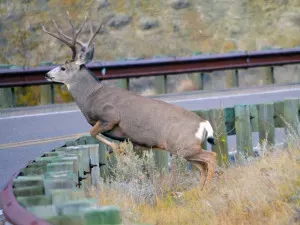By Linda Pauer
While studying biology at UC Davis in the 70’s, hoping to become a veterinarian, only a handful of students were interested in ecology. I did not become a vet, with no regrets. But, since then, my interest in ecology – the study of the relationship between living organisms and their physical environment – has blossomed and expanded. Nowadays, many brilliant young minds study road ecology, wildlife connectivity modeling, and transportation design: addressing sustainable transportation systems with an understanding of the impact they have on natural landscapes and human communities. One of the things that has emerged from these studies is our concern for the high cost of roadkill, not just to the animals who suffer, but to humans as well.
The Economic Data
A side benefit of the growth of interest in ecology is that UC Davis now offers public access to its resources and reports including a 2023 California Roadkill Hotspots Report, the California Roadkill Observation system, and updates on funding for wildlife crossings. Wildlife Crossing Manuals and Wildlife-Vehicle Conflict Data Collection are easy to find, including the “French Fauna Passage Manual 2023.” Here, more than 300 downloadable pages (in English) may help us understand how to prevent roadkill. The manual offers an objective analysis of the feasibility, efficacy and economic acceptability of measures to conserve the fauna of France. From an economic point of view, it estimates that collisions with large ungulates cost the French government between 115 and 180 million euros ($122 MM and $190 MM, respectively) for about 23,500 collisions (Vignon and Barbarreau, 2008). The same website hosts manuals for designing crossings and bridges from the US and other global sources.
The homework has also been done in Washington state as well, where mule deer migrate to winter ranges by crossing a busy transportation corridor that cuts through their path from the mountains to the valleys. Researchers offer an analysis that argues that the cost of building wildlife crossings is outweighed by their economic benefits over time, amounting to benefits of $235,000 to $443,000 in 2021 US dollars annually because of fewer car wrecks.

At the UC Davis Road Ecology Center, a report by Fraser Shilling et.al., (2/1/2023) covers trends in mountain lion roadkill. Their data shows that about 70 mountain lions are hit on California highways every year, many of them clustered in Southern California. It estimates that between 2016 and 2020 the cost of reported events was at least $1 billion. And as high as $2 billion if mule deer crashes are included (Table 2, pp. 17 - 18). These cost calculations consider hospital bills, property damage, car repairs and maintenance of the road. In his book on road ecology, Crossings: How Road Ecology Is Shaping the Future of Our Planet Ben Goldfarb reports, “All told, animal crashes were costing America more than $8 billion per year.”
More importantly than the cost to humans, the cost to a wildlife species comes into play. The full report by Shilling, et al. (9/25/2023) considers trends in wildlife populations and argues that mule deer and coyote populations are “in decline, possibly due to excessive rates of traffic collisions.” Consider how long it takes to re-establish a species like mountain lions, bobcat or deer, to name a few. For example, the mountain lion Uno was pregnant, and we lost both her and her kittens. In cases like this when the kittens survive, the efforts of veterinary teams are high and costly in taking care of the young survivors and training them before releasing them back into the wild.
I think the homework has been done. But how do wildlife crossings get funded? In the next issue you can read about the California Department of Fish & Wildlife's priorities for financing safe wildlife movement - good news!